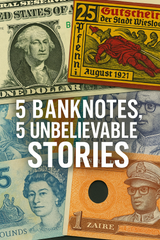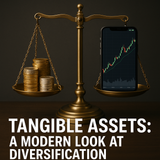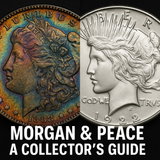The Ultimate Guide to Morgan and Peace Silver Dollars: A Collector's Journey Through American History
To hold a classic American silver dollar is to hold a tangible piece of the nation’s soul. It is not merely a coin; it is a substantial disc of precious metal, cool to the touch, bearing the weight of history in its 26.73 grams of 90% silver. Its heft speaks of a time when money was real, mined from the earth and stamped with symbols of national identity. In the world of United States numismatics, no two coins capture this feeling more powerfully than the Morgan and Peace silver dollars. They are arguably the most iconic, widely collected, and historically significant series ever produced by the U.S. Mint.
These two coins serve as metallic bookends to a transformative period in American history. The Morgan dollar, born of political strife and the vast silver strikes of the Wild West, is the definitive coin of America's Gilded Age and westward expansion.
This guide is designed to be the definitive resource for understanding, collecting, and appreciating these historic coins. We will delve into their complex origin stories, analyze their celebrated artistic merits, and provide the essential knowledge every collector—from the novice to the seasoned enthusiast—needs to navigate the rewarding journey of building a meaningful collection.
Part I: The Morgan Dollar (1878-1921) – Forging a Nation in Silver
Chapter 1: The Political Cauldron: Birth of the Morgan Dollar
The story of the Morgan dollar is not one of commerce, but of pure political power. Its creation was not a response to public demand for a large silver coin—in fact, demand was virtually nonexistent—but rather the result of a titanic struggle between powerful industrial and agrarian interests that defined late 19th-century America.
The stage was set by the Coinage Act of 1873. This legislation officially put the United States on the gold standard and ended the free coining of silver, a practice where citizens could bring silver bullion to the Mint and have it coined for a small fee. For silver mining barons in the West, who had recently unearthed the colossal Comstock Lode in Nevada, this was a catastrophe.
This "free silver" movement exerted immense pressure on Congress to resume silver coinage. The result was the Bland-Allison Act of 1878, a contentious political compromise. The act did not restore free coinage but instead mandated that the U.S. Treasury purchase between $2 million and $4 million worth of silver bullion from western mines every single month at above-market prices and mint it into legal tender dollars.
This origin is fundamental to understanding the Morgan dollar as a collectible. Because the public did not want or need millions of new, heavy silver dollars, the vast majority of the coins minted were immediately placed into canvas bags and stored in Treasury vaults, where many sat untouched for over 80 years.
Chapter 2: The Artist and the Engraver: The Design of an Icon
With the Bland-Allison Act passed, the U.S. Mint needed a design for its new dollar, and it needed one fast. Mint Director Henry P. Linderman, a man deeply dissatisfied with what he saw as the declining artistic quality of American coinage, saw an opportunity. He had already recruited a talented 30-year-old English engraver, George T. Morgan, from the prestigious British Royal Mint in 1876.
Morgan's arrival created immediate tension within the U.S. Mint's engraving department, which was dominated by the father-son team of William and Charles Barber. The Barbers viewed Morgan as an outsider and a threat to their authority.
Morgan was determined to create a uniquely American coin. Rejecting the traditional Greco-Roman profiles for Lady Liberty, he sought a real American woman to serve as his model.
The resulting design was a masterpiece of its time:
-
Obverse: The obverse features Morgan's powerful portrait of Liberty. She wears a Phrygian cap, a classical symbol of emancipation, which is adorned with two staples of American agriculture: cotton blossoms and heads of wheat.
12 E PLURIBUS UNUM arches above her head, while 13 stars representing the original colonies line the lower rim. Morgan placed his initial, "M," at the base of Liberty's neck.
12 -
Reverse: The reverse depicts a bald eagle with its wings spread, a symbol of American strength. It clutches both an olive branch, for peace, and a bundle of arrows, signifying a readiness for war.
12 IN GOD WE TRUST appears between the eagle's wings. The design was not without its critics; some found the eagle too thin and scrawny, giving the coin the early nickname "buzzard dollar".
9 12
Even the coin's launch was marked by a small controversy. The initial 1878 reverse die featured an eagle with eight tail feathers. Ornithologists quickly pointed out that bald eagles always have an odd number of tail feathers. The Mint corrected the design to seven feathers, creating several popular and collectible varieties for the first year of issue, including the "8 Tail Feathers," the "7 over 8 Tail Feathers," and the final "7 Tail Feathers" designs.
Chapter 3: A Collector's Deep Dive: Morgan Dollar Key Dates & Varieties
For collectors, the appeal of the Morgan dollar series lies in its vastness and complexity. With 96 regular issues spanning five different mints (Philadelphia, San Francisco, New Orleans, Carson City, and Denver), building a complete set is a monumental but rewarding challenge. A coin's rarity in this series is determined by a combination of its original mintage, its survival rate after massive government melts (most notably the 1918 Pittman Act, which destroyed over 270 million Morgans), and its availability in high-grade, uncirculated condition.
The Absolute Keys
-
1893-S: The undisputed "King of Business Strike Morgans." Its extreme rarity is due to two factors: a minuscule mintage of just 100,000 coins and the economic turmoil of its time.
17 6 18 -
1895: Known as the "King of the Morgan Series," this coin is a numismatic mystery. Philadelphia Mint records indicate that 12,000 business-strike dollars were produced in 1895. However, not a single one has ever been authenticated.
18 19 17
Major Branch Mint Rarities
-
1889-CC: The crown jewel of the Carson City issues. After a four-year hiatus, the Carson City Mint struck only 350,000 dollars in 1889.
17 17 -
1884-S: This is a classic "conditional rarity." While the San Francisco Mint produced a healthy 3.2 million examples, the coins were workhorses, released directly into the bustling economy of the West where they circulated extensively.
11 17
The table below provides a quick-reference guide to the most significant key dates in the Morgan dollar series, offering crucial data for informed collecting.
| Date/Mint Mark | Mintage | Reason for Rarity |
| 1893-S | 100,000 |
Lowest business strike mintage of the series; very few survive in any grade. |
| 1895 (Proof) | 880 |
Proof-only issue; no known business strikes exist, making it the ultimate series "stopper". |
| 1889-CC | 350,000 |
Rarest Carson City issue; extremely low survival rate due to melting. |
| 1894-P | 110,000 |
Second-lowest Philadelphia mintage; a significant rarity, though some bags were found in the 1960s. |
| 1895-O | 450,000 |
Low mintage and notoriously poor strike quality; well-struck, lustrous examples are very scarce. |
| 1884-S | 3,200,000 |
Classic conditional rarity; high mintage but almost all were heavily circulated, making uncirculated examples exceptionally rare. |
| 1903-O | 4,450,000 |
Conditional rarity; high mintage but most are poorly struck and heavily bag-marked, making high-grade examples elusive. |
Part II: The Peace Dollar (1921-1935) – A Symbol of a New Era
Chapter 4: From War to Peace: The Genesis of a New Dollar
If the Morgan dollar was a product of political machination and industrial greed, the Peace dollar was its antithesis: a coin born from the collective will of a nation yearning for tranquility. In the aftermath of the unprecedented devastation of World War I, a powerful public movement arose to create a circulating coin that would commemorate the return of peace.
This movement was spearheaded not by politicians or mining magnates, but by the numismatic community itself. Prominent coin collectors and writers, most notably Frank Duffield and Farran Zerbe, began advocating for a "peace coin" as early as 1918.
Their timing was perfect. The Pittman Act of 1918, which had resulted in the melting of hundreds of millions of Morgan dollars, also mandated that the silver be replaced with new dollar coins, providing the legal and material justification for a new issue.
Chapter 5: The Sculptor's Vision: An Art Deco Masterpiece
To find a design worthy of symbolizing peace, the U.S. Commission of Fine Arts held a competition, inviting eight of the nation's most prominent sculptors to participate.
Pressed for time, de Francisci used his young wife, Teresa, as the model for his vision of Liberty.
The reverse design, however, nearly derailed the entire project. De Francisci's original, approved model featured a majestic eagle perched on a mountain top, clutching an olive branch. But at the request of Mint officials, he added a broken sword to the design, meant to symbolize disarmament.
The first Peace dollars, struck in the final days of December 1921, were produced in a stunning high relief to capture the full artistic depth of de Francisci's sculpture.
Chapter 6: A Collector's Deep Dive: Peace Dollar Key Dates & Varieties
The Peace dollar series is much shorter than the Morgan series, running from 1921 to 1928 and again from 1934 to 1935. This makes a complete set more attainable, but it contains several key challenges that are prized by collectors.
The One-Year Type: 1921 High Relief
The 1921 Peace dollar is a favorite among collectors for two main reasons. First, it is the inaugural issue of the series. Second, and more importantly, it is the only year struck in the artist's intended high relief.
The Series Key: 1928-P
The 1928 Peace dollar, struck at the Philadelphia Mint (and thus bearing no mint mark), is the undisputed king of the series. It boasts the lowest mintage of any regular issue, with a mere 360,649 coins produced.
The Conditional Rarity: 1934-S
Similar to the 1884-S Morgan, the 1934-S Peace dollar is a conditional rarity. Its mintage of just over one million is not the series' lowest, but the coin is exceptionally difficult to find in high-grade, uncirculated condition.
The table below summarizes the essential information for the key dates of the Peace dollar series.
| Date/Mint Mark | Mintage | Reason for Rarity |
| 1921 (High Relief) | 1,006,473 |
One-year-only high relief design; a popular type coin with striking challenges. |
| 1928-P | 360,649 |
Lowest mintage of the series; production ceased when Pittman Act silver ran out. |
| 1934-S | 1,011,000 |
Conditional rarity; low survival rate in uncirculated grades makes Mint State examples very scarce. |
| 1927-D | 1,268,900 | A semi-key date that is notably difficult to find with a strong strike and good luster. |
Part III: The Science and Art of Collecting
Chapter 7: The Foundation of Value: A Professional's Guide to Coin Grading
In modern numismatics, a coin's value is inextricably linked to its condition, or "grade." For a new collector, understanding the principles of grading is the single most important step toward building a collection of lasting value.
The Sheldon Scale (1-70) Explained Simply
The industry standard for grading is the 70-point numerical scale developed in the 1940s by Dr. William Herbert Sheldon.
The scale is divided into two main categories:
-
Circulated Grades (1-58): These coins show evidence of wear from being used in commerce. Key levels include Poor (PO-1), Good (G-4), Very Good (VG-8), Fine (F-12), Very Fine (VF-20), Extremely Fine (XF-40), and About Uncirculated (AU-50 to AU-58). The higher the number, the less wear is visible.
34 -
Uncirculated or Mint State (MS) Grades (60-70): These coins show no trace of wear from circulation. The grades from MS-60 to MS-70 differentiate coins based on the quality of their original strike, the brilliance of their luster, and the number and severity of any contact marks or scratches acquired from handling at the mint.
35 34
The Role of Third-Party Grading (TPG)
In the 1980s, the coin market was plagued by inconsistent and subjective grading, which eroded collector confidence. The emergence of independent, third-party grading services revolutionized the hobby. These companies provide three critical functions:
-
Authentication: Experts verify that the coin is genuine and has not been altered.
38 -
Grading: A team of professional graders assigns a consensus grade based on the 70-point scale.
38 -
Encapsulation: The coin is sealed in a tamper-evident, inert plastic holder (a "slab") with a label displaying its grade and a unique certification number.
39
This system creates a trusted, liquid market. A collector can buy a certified coin with confidence, knowing its authenticity and grade are guaranteed by a reputable company.
PCGS vs. NGC: A Nuanced Comparison for the Silver Dollar Collector
The two undisputed leaders in third-party grading are the Professional Coin Grading Service (PCGS), founded in 1985, and the Numismatic Guaranty Company (NGC), founded in 1987.
The most critical distinction lies in market perception and resale value. For classic U.S. coins like Morgan and Peace dollars, PCGS-graded examples consistently command a market premium, often selling for 5% to 15% more than an identically graded coin from NGC.
The choice between them is not about which is "better," but which is strategically right for a specific coin and a specific collector. For a top-tier, investment-grade key date like an 1893-S Morgan, the potential six-figure value makes the PCGS premium a significant financial consideration, likely justifying any higher grading fee. For a common-date but beautifully toned coin where personal eye appeal is the primary driver, an NGC holder may be a more cost-effective and equally satisfactory choice. Many sophisticated collectors use both services, submitting different coins to each based on these strategic considerations.
| Your Priority | Recommended Service | Key Considerations |
| Maximum Resale Value on a Key Date | PCGS |
The market consistently pays a premium for PCGS-graded classic U.S. rarities. The higher grading fee is often offset by the higher final value. |
| Cost-Effective Grading for Common Dates | NGC |
For coins where a market premium is less of a factor, NGC's lower fees can be advantageous. Excellent for building a high-quality set on a budget. |
| Collecting Toned Coins | Either / Collector Preference | Both services recognize and grade naturally toned coins. The choice often comes down to personal preference for the holder design or market trends for specific types of toning. |
| Variety Collecting (e.g., VAMs) | NGC |
NGC is widely recognized for its more comprehensive attribution services for the many minor die varieties (known as VAMs) found on Morgan and Peace dollars. |
Chapter 8: The Allure of Color: Understanding and Valuing Coin Toning
Among the most captivating aspects of collecting silver dollars is the phenomenon of toning. Far from being damage, attractive natural toning is a highly prized characteristic that can elevate a common coin into a unique work of art.
The Science of Toning
Toning is the result of a slow, natural chemical reaction on the surface of a coin—a form of oxidation.
The spectacular "rainbow" colors are not pigments on the coin. They are an optical illusion created by a process called thin-film interference. As the chemical reaction occurs, it forms an infinitesimally thin, transparent layer of silver sulfide on the coin's surface. Light passing through this film is refracted. Depending on the exact thickness of the film at any given point, certain wavelengths (colors) of light are canceled out, while others are reflected back to the viewer's eye.
Natural vs. Artificial Toning
The key to value is the toning's origin. Collectors prize natural toning that has developed slowly and evenly over a long period. The most famous examples are "monster" rainbow-toned Morgan dollars that resulted from coins sitting for nearly a century in their original canvas mint bags.
Collectors and grading services universally reject artificial toning, where chemicals or heat are used to rapidly induce coloration on a coin.
Toning and Value
The impact of toning on a coin's value is dramatic but subjective. Aesthetically pleasing, natural rainbow toning can increase a common-date coin's value exponentially, with exceptional examples selling for many times the price of their untoned counterparts.
Conclusion: Your Journey into Classic American Silver
The Morgan and Peace silver dollars are more than just metal; they are pillars of American numismatics and tangible chronicles of the nation's story. The Morgan dollar, born from the raw ambition of the Gilded Age, tells a story of industrial might, political power, and the taming of the West. The Peace dollar, with its serene Art Deco beauty, speaks to a nation's profound hope for a better world after a global cataclysm. Together, they offer a lifetime of study, discovery, and enjoyment.
Whether you are an investor seeking tangible assets with historical significance, a historian fascinated by the stories captured in silver, or a collector driven by the thrill of the hunt, these two remarkable series offer a rewarding path. Each coin is a chapter, and each collection is a library of American history.
Ready to own a piece of American history? Explore our curated collection of certified Morgan and Peace silver dollars today.
Explore Popular Articles
Pocket-Sized History: 5 Banknotes with Unbelievable Stories
It's more than just money. Every banknote in your wallet—or your collection—is a pocket-...
An Analytical Framework for Tangible Assets in Portfolio Diversification: A Study of Precious Metals and Numismatics
This report is for educational and informational purposes only and does not constitute financial, in...
The Ultimate Guide to Morgan and Peace Silver Dollars: A Collector's Journey Through American History
To hold a classic American silver dollar is to hold a tangible piece of the nation’s soul. It...




